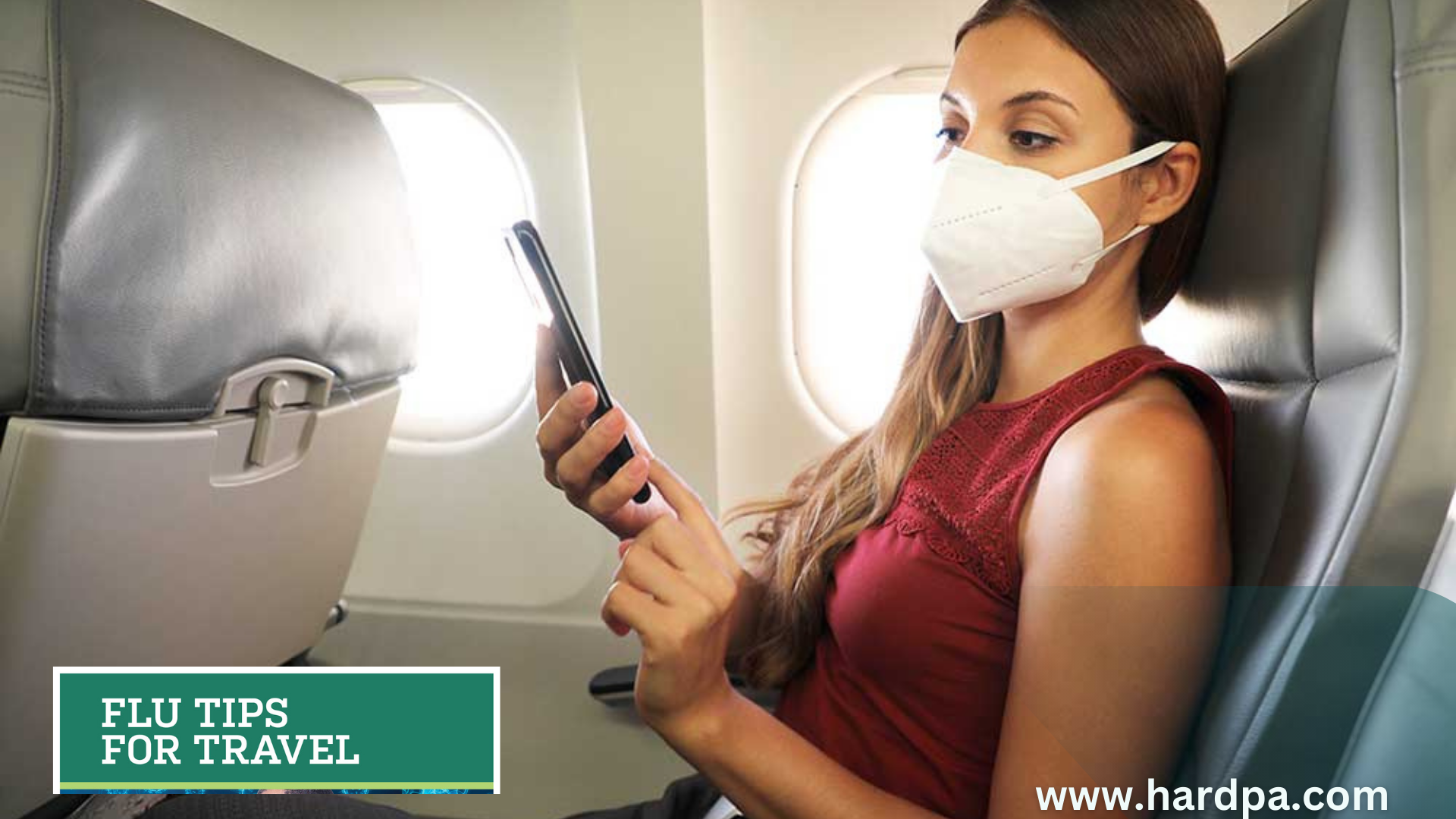Flu season, which normally occurs in the fall and winter, poses its own set of concerns for travelers. To reduce the danger of catching the flu or spreading it, travel during this time must be planned carefully. In this post, we’ll cover measures and recommendations for controlling travel during flu season so that you and others around you can travel safely and healthily.
Understanding the Flu Season
Influenza, commonly known as the flu, is a contagious respiratory illness caused by influenza viruses. Flu season in the Northern Hemisphere typically spans from October to April, peaking in December and February. During this time, the likelihood of contracting the flu increases due to factors such as colder temperatures and increased indoor gatherings, making it essential to take preventive measures while traveling.
Pre-Travel Preparations
1. Check the Flu Season Timing and Severity
Before planning any travel, it’s crucial to check the flu season status in your region of departure and destination. Stay informed about the timing and severity of the flu season to make an informed decision about whether to proceed with your travel plans.
2. Consult with a Healthcare Professional
If you have underlying health conditions or concerns about traveling during flu season, consult a healthcare professional. They can provide advice based on your medical history and condition, recommending precautions or potential adjustments to your travel plans.
3. Get a Flu Vaccine
One of the most effective ways to protect yourself and others from the flu is by getting a flu vaccine. Ideally, you should get vaccinated at least two weeks before your trip to ensure your body has time to build immunity. Check with your healthcare provider for the appropriate timing and type of flu vaccine for your circumstances.
4. Pack Necessary Supplies
While packing for your trip, include a travel health kit that consists of items like hand sanitizer, tissues, disinfectant wipes, and face masks. These supplies will help you maintain good hygiene and reduce the risk of flu transmission during your journey.
During-Travel Precautions
1. Practice Good Hand Hygiene
Frequent handwashing with soap and water for at least 20 seconds is one of the most effective ways to prevent the spread of the flu virus. If soap and water are not available, use an alcohol-based hand sanitizer with at least 60% alcohol.
2. Wear a Mask
Wearing a mask, especially in crowded or enclosed spaces such as airports, train stations, or buses, is essential to reduce the risk of inhaling or exhaling respiratory droplets that may contain the flu virus.
3. Avoid Touching Your Face
Refrain from touching your face, especially your eyes, nose, and mouth, to prevent the transfer of flu viruses from contaminated surfaces to your mucous membranes.
4. Maintain Physical Distancing
Practice physical distancing by keeping a safe distance (at least six feet) from others, particularly in crowded areas. This reduces the likelihood of coming into contact with flu-infected individuals.
5. Cover Your Mouth and Nose
Cover your mouth and nose with a tissue or your elbow when you cough or sneeze to prevent the spread of respiratory droplets. Dispose of used tissues in a lined trash can and immediately wash your hands.
6. Stay Informed
Stay updated on the latest travel advisories, restrictions, and health guidelines for your destination. Be prepared for potential changes in plans based on evolving circumstances.
Post-Travel Practices
1. Monitor Your Health
After returning from your trip, monitor your health for any flu-like symptoms, such as fever, cough, sore throat, fatigue, or body aches. If you experience any symptoms, seek medical attention and inform healthcare professionals about your recent travel history.
2. Isolate if Necessary
If you develop symptoms of the flu or any respiratory illness after your trip, consider self-isolating to prevent the potential spread of the virus to others. Follow local health guidelines and consult a healthcare professional for further advice.
3. Report and Contact Tracing
If you test positive for the flu or any respiratory illness after your trip, cooperate with contact tracing efforts to identify individuals you may have come into close contact with during your travels. This aids in preventing further transmission of the virus.
4. Maintain Hygiene Practices
Continue practicing good hygiene habits, such as handwashing, wearing masks, and avoiding close contact with sick individuals, even after your trip, to reduce the risk of flu transmission in your community.
Conclusion
Traveling during flu season requires a proactive and cautious approach to ensure the health and safety of both yourself and the people around you. By staying informed, taking preventive measures, and following recommended guidelines, you can minimize the risk of contracting or spreading the flu while traveling. It’s essential to prioritize public health and contribute to the collective effort in preventing the spread of influenza during the flu season and beyond.
Image: BigStock



58 comments
plumbing san jose ca http://www.plumbersan-joseca4.com/ .
Изучите основы работы с shining 3D,
Узнайте о преимуществах работы с shining 3D,
Сравнение методов 3D сканирования: shining 3D vs другие технологии,
Какими особенностями обладает 3D моделирование с shining 3D?,
Откройте для себя инновационные подходы к 3D сканированию от shining 3D,
Как начать работу с программой shining 3D,
Изготовление профессиональных 3D моделей при помощи shining 3D,
Получение качественных 3D отсканированных данных с shining 3D,
Как правильно настроить и откалибровать устройство shining 3D,
Советы по использованию shining 3D в дизайне,
Интеграция 3D моделей от shining 3D в проекты,
Какие преимущества дает работа с shining 3D перед конкурентами?,
Топ-10 фишек программы shining 3D,
Обучение 3D моделированию с shining 3D: где начать?,
Как работать с технологией 3D сканирования на профессиональном уровне с shining 3D?,
Изучение новейших технологий 3D сканирования с участием shining 3D,
Создание реалистичных 3D моделей с помощью shining 3D,
Примеры успешного применения shining 3D в различных отраслях,
Мифы и реальность работы с 3D сканированием от shining 3D
3d принтер shining 3d https://3sh-eincan.ru .
Сравнение anycubic kobra 2 neo с другими моделями
anycubic kobra 2 neo http://ycuic-obraeo.ru .
Качественный выбор Picaso Designer Classic
picaso designer classic https://paso-signssic.ru/ .
Лучший выбор для творчества: 3D принтер Picaso Designer X S2, для ваших творческих идей.
Современный дизайн и инновационные технологии в 3D принтере Picaso Designer X S2, который изменит ваш взгляд на создание моделей.
Доступное и качественное решение для дизайнеров: 3D принтер Picaso Designer X S2, которое подарит вам новые возможности и перспективы.
Мощный инструмент для прототипирования и дизайна: 3D принтер Picaso Designer X S2, который станет вашим незаменимым помощником в работе.
Лучший выбор для профессиональных дизайнеров: 3D принтер Picaso Designer X S2, который поразит вас своей эффективностью и надежностью.
Почувствуйте мощь технологии с 3D принтером Picaso Designer X S2, который отличается высоким качеством печати и точностью деталей.
Новейший 3D принтер Picaso Designer X S2 для дизайнеров и инженеров, который поможет вам воплотить ваши идеи в жизнь.
Уникальные возможности для творчества с 3D принтером Picaso Designer X S2, которое подарит вам новый уровень ваших проектов.
Уникальный инструмент для инженеров и дизайнеров: 3D принтер Picaso Designer X S2, которое обеспечит вас всем необходимым для воплощения идей.
Удивительные возможности для создания моделей с 3D принтером Picaso Designer X S2, который не оставит вас равнодушными.
Оптимальное решение для моделирования: 3D принтер Picaso Designer X S2, который поможет вам реализовать любые проекты.
Превосходное качество печати и скорость работы: 3D принтер Picaso Designer X S2, которое подарит вам новый взгляд на создание моделей.
Инновационное решение для прототипирования: 3D принтер Picaso Designer X S2, который поможет вам воплотить свои идеи в реальность.
Продуктивное оборудование для творчества: 3D принтер Picaso Designer X S2, который превзойдет ваши ожидания.
Революционный 3D принтер Picaso Designer X S2 для ваших проектов, которое станет вашим верным помощником в работе.
Создайте будущее с 3D принтером Picaso Designer X S2, который поможет вам воплотить ваши идеи в жизнь.
Уникальные возможности и инновационные технологии в 3D принтере Picaso Designer X S2
picaso designer x s2 отзывы http://aso-design2.ru/ .
Революционный 3D сканер от компании Revopoint, сравнение 3D сканеров Revopoint и других брендов, как улучшить процесс сканирования с помощью 3D сканера Revopoint, подробный обзор 3D сканера Revopoint, почему стоит обратить внимание на 3D сканер Revopoint Tanso S1, как использовать 3D сканер Revopoint в дизайне интерьера, 3D сканер Revopoint для профессионалов: особенности использования, популярные модели 3D сканеров от Revopoint, Revopoint 3D сканер: инструкция по использованию, 3D сканер Revopoint: новые возможности для архитекторов, основные критерии выбора 3D сканера для медицинских целей, Revopoint 3D сканер для революционных идей: как использовать, преимущества использования 3D сканера Revopoint в строительстве, практические советы по использованию 3D сканера Revopoint в промышленности, новые возможности для хобби и творчества с 3D сканером от Revopoint, почему 3D сканер от Revopoint – лучший выбор для быстрого сканирования, новые возможности для VR проектов с 3D сканером Revopoint, 3D сканер Revopoint: превосходное качество сканирования.
revopoint купить https://www.vop-rewoint4.ru .
best online pharmacies in mexico: mexican online pharmacy – buying from online mexican pharmacy
medication from mexico pharmacy: mexican border pharmacies shipping to usa – mexico pharmacies prescription drugs
buying prescription drugs in mexico
http://cmqpharma.com/# buying from online mexican pharmacy
mexico drug stores pharmacies
buying from online mexican pharmacy
https://cmqpharma.com/# buying prescription drugs in mexico online
medication from mexico pharmacy
pharmacies in mexico that ship to usa
https://cmqpharma.com/# mexican pharmaceuticals online
п»їbest mexican online pharmacies
buying from online mexican pharmacy
http://cmqpharma.com/# buying from online mexican pharmacy
mexican online pharmacies prescription drugs
pharmacies in mexico that ship to usa: cmq pharma mexican pharmacy – mexican drugstore online
buying prescription drugs in mexico: online mexican pharmacy – medication from mexico pharmacy
Hello there, just became aware of your blog through Google,
and found that it’s really informative. I am going to watch out for brussels.
I will appreciate if you continue this in future. A lot of people will be benefited from your writing.
Cheers! Escape room
Лучшие места для покупки SLS принтеров, что учитывать при покупке SLS принтера.
Какие SLS принтеры пользуются популярностью?, почему стоит заказать SLS принтер через интернет.
Где можно безопасно приобрести SLS принтеры?, цены на SLS принтеры: где дешевле?.
Как не ошибиться с выбором SLS принтера?, только надежные SLS принтеры в продаже.
Оригинальные SLS принтеры по выгодным ценам, подбор SLS принтера по требованиям.
sls 3d принтер купить http://www.slsdd-printer32.ru .
Топ магазинов, где можно приобрести промышленный 3D принтер | Как выбрать промышленный 3D принтер | Какой промышленный 3D принтер выбрать | Магазины с широким выбором промышленных 3D принтеров | Специальные предложения на промышленные 3D принтеры | Топ бренды промышленных 3D принтеров | Почему стоит выбрать промышленный 3D принтер | Виды материалов для промышленных 3D принтеров | Плюсы и минусы покупки промышленного 3D принтера
3д принтер промышленный цена promddd-printer2.ru .
Лучшие предложения на 3D принтеры для ювелирного производства, Где заказать 3D принтер для создания украшений, Ювелирный 3D принтер для ваших идей, Суперпредложение: 3D печать для ювелиров, Подберите идеальный 3D принтер для производства украшений, Гарантированно низкие цены на 3D принтеры для ювелиров, 3D печать для ювелиров: все лучшие модели в наличии, Лучшие цены на ювелирные 3D принтеры, Успейте купить качественный 3D принтер для ювелиров по акции, Скидки на 3D принтеры для производства украшений, Эффективная 3D печать для ювелиров: все модели в наличии, Идеальные 3D принтеры для создания украшений, Выбор ювелира: 3D принтер по доступной цене, Технологии 3D печати для ювелиров: только проверенные модели, Эксклюзивные 3D принтеры для ювелиров: скидки и акции, Где купить высококачественный 3D принтер для ювелиров, Специальное предложение: 3D принтеры для ювелира.
ювелирный 3d принтер купить http://printerddd-yuvelirnyj3.ru/ .
Покупайте только лучшие 3д принтеры от отечественного производителя, на всю линейку.
Купить 3д принтер отечественного производства с доставкой по России, со скоростью молнии.
3д принтеры российского производства – надежность и качество, доказано практикой.
Экономьте на доставке и покупайте 3д принтеры российского производства у нас, без лишних затрат.
Почему стоит купить 3д принтер российского производства?, которые удивят вас.
Лучшие 3д принтеры одобрены российскими специалистами, покупайте с уверенностью.
Только лучшие 3д принтеры от отечественного производителя, для вашего успеха.
Технологии будущего: 3д принтеры российского производства, уже доступны.
Локальное производство – выгодно и удобно, продукция отечественных производителей.
принтер российского производства купить rsu-dd3print.ru .
Как выбрать лазерный 3D сканер для профессионального использования, сравнение моделей.
Выбор профессионалов – лазерные 3D сканеры, гарантированное качество.
Продажа лазерных 3D сканеров с доставкой по всей стране, скидки и акции.
Новинки рынка – лазерные 3D сканеры, полезные советы.
Где найти надежного производителя лазерных 3D сканеров?, сравнение цен.
лазерный 3d сканер купить лазерный 3d сканер купить .
Современные технологии в промышленном 3D сканере, легкость в использовании.
Что нужно знать перед покупкой промышленного 3D сканера, критерии выбора.
Как увеличить эффективность производства с помощью 3D сканирования, примеры успешного применения.
Как защитить свои данные при работе с промышленным 3D сканером, способы обеспечения конфиденциальности.
Современный подход к промышленному 3D сканированию, возможности оптимизации.
3d сканер промышленный купить http://promyshlennyj3d-skaner6.ru/ .
для вашего комфорта,
для вашего производства,
RangeVision Pro: новейшие разработки в области 3D-сканирования,
Доверьтесь профессионалам и выберите RangeVision Pro,
RangeVision Pro: надежность в каждой детали,
Новые возможности с RangeVision Pro,
RangeVision Pro: доверьтесь опыту лидера,
RangeVision Pro: инструмент современного профессионала,
RangeVision Pro: сделайте качество вашим стандартом,
RangeVision Pro: высочайший уровень качества.
сканер rangevision pro http://range-vision56pro.ru/ .
Почему стоматологические 3D-принтеры – это будущее стоматологии|Какие модели стоматологических 3D-принтеров существуют сегодня|Какие критерии отбора нужно учитывать при выборе стоматологического 3D-принтера|Какие материалы используются для печати стоматологических конструкций|Секреты использования 3D-принтеров в стоматологии|Как 3D-принтеры меняют стоматологию|3D-принтеры в стоматологии: современные возможности и перспективы|Что такое биопечать и как она меняет стоматологию|Новые возможности для стоматологии: как принципы 3D-печати меняют отрасль|Сравнение стоматологических 3D-принтеров: какой выбрать для своей клиники|Инновационные решения для стоматологических клиник с помощью 3D-принтеров|Какие перспективы открывает 3D-печать для стоматологических клиник|Инновации в стоматологии: перспективы применения 3D-печати|Стоматологические 3D-принтеры: улучшение качества обслуживания пациентов|Что такое биопечать и как она меняет стоматологию|3D-принтеры в стоматологии: современные возможности и перспективы
зуботехнический 3d принтер https://stomatologicheskie34-printery.ru .
Лучшее решение для 3D-сканирования | Подробное руководство по работе с Einscan H2 | Подробное руководство по началу работы с Einscan H2 | Инновационные функции Einscan H2 | Лучшие программы для совместной работы с Einscan H2 | Профессиональное использование Einscan H2 для 3D-разработок | Секреты оптимизации скорости работы с Einscan H2 | Как выбрать оптимальные настройки для Einscan H2 | Способы ускорения процесса работы с Einscan H2 | Оптимальные варианты покупки Einscan H2 с доставкой | Как выбрать лучший вариант для своих задач: Einscan H2 или другие модели | Einscan H2: идеальный инструмент для 3D-печати | Профессиональный подход к подготовке моделей для печати с Einscan H2 | Профессиональные советы по оптимизации работы с Einscan H2
einscan h2 https://www.nscan3d-h2.ru/ .
Оцените преимущества 3D-сканера RangeVision Smart, изучите особенности.
Уникальные возможности 3D-сканера RangeVision Spectrum, выберите лучший вариант.
Почему стоит выбрать 3D-сканер RangeVision PRO, получите консультацию.
Выберите идеальный 3D-сканер RangeVision, исходя из ваших целей.
Погрузитесь в мир современных технологий с RangeVision, познакомьтесь с ассортиментом.
rangevision https://www.ngevision-rt3.ru .
best online pharmacies in mexico: purple pharmacy mexico price list – buying from online mexican pharmacy
mexico drug stores pharmacies mexico pharmacies prescription drugs п»їbest mexican online pharmacies
https://indiapharmast.com/# buy prescription drugs from india
canadadrugpharmacy com: online canadian pharmacy – canadian pharmacy store
mexican drugstore online: purple pharmacy mexico price list – purple pharmacy mexico price list
online pharmacy india reputable indian pharmacies india online pharmacy
canadian pharmacy world: pharmacy wholesalers canada – reputable canadian online pharmacy
mexico pharmacies prescription drugs: pharmacies in mexico that ship to usa – mexican pharmacy
http://indiapharmast.com/# Online medicine home delivery
best online pharmacy india: india pharmacy – pharmacy website india
pharmacy canadian legit canadian pharmacy canadian pharmacy ratings
buying from online mexican pharmacy: п»їbest mexican online pharmacies – п»їbest mexican online pharmacies
top 10 online pharmacy in india: online pharmacy india – best india pharmacy
mexican pharmaceuticals online: buying prescription drugs in mexico – mexico pharmacy
https://indiapharmast.com/# buy medicines online in india
india pharmacy mail order cheapest online pharmacy india pharmacy website india
canada drugs online: legal to buy prescription drugs from canada – buying from canadian pharmacies
http://doxycyclinedelivery.pro/# how much is doxycycline cost
doxycycline 50mg tab: doxycycline pharmacy price – doxycycline 100 mg
https://doxycyclinedelivery.pro/# doxycycline mexico
doxycycline 100mg tablets coupon: doxycycline 163 – cost of doxycycline in canada
https://amoxildelivery.pro/# amoxicillin price canada
http://doxycyclinedelivery.pro/# 100 doxycycline
paxlovid india: paxlovid covid – п»їpaxlovid
https://amoxildelivery.pro/# amoxicillin 50 mg tablets
http://paxloviddelivery.pro/# paxlovid cost without insurance
where to buy amoxicillin over the counter: amoxicillin 500mg capsules – amoxicillin 500 mg online
https://paxloviddelivery.pro/# paxlovid covid
ciprofloxacin order online: buy cipro online usa – buy generic ciprofloxacin
https://ciprodelivery.pro/# cipro online no prescription in the usa
https://doxycyclinedelivery.pro/# doxycycline 100mg price uk
doxycycline south africa: can you buy doxycycline over the counter in south africa – buy doxycycline pills online
where can i get generic clomid without a prescription: how to get generic clomid pill – generic clomid no prescription